Scottish Schools Adolescent Lifestyle and Substance Use Survey (SALSUS): mental wellbeing report 2018
Mental health and wellbeing findings from the 2018 wave of the Scottish Schools Adolescent Lifestyle and Substance Use Survey (SALSUS).
This document is part of a collection
4 Emotional and behavioural problems, mental wellbeing and family
The family circumstances analysed in this chapter are the pupil's family structure, whether they are likely to talk to their parents about something worrying them, and parental awareness of their activities. These variables are analysed using the overall SDQ score and the mean WEMWBS score to determine whether each family variable was correlated with emotional and behavioural problems and mental wellbeing, respectively.
Family structure
Emotional and behavioural problems
A pupil's family structure was associated with emotional and behavioural problems. Pupils who live with both parents were less likely to have a borderline or abnormal overall SDQ score than those in other family situations. Just under a quarter of pupils who lived with a single parent, and just over a quarter of those who had a step-parent living with them at home, had a borderline or abnormal overall SDQ score (Figure 4.1).
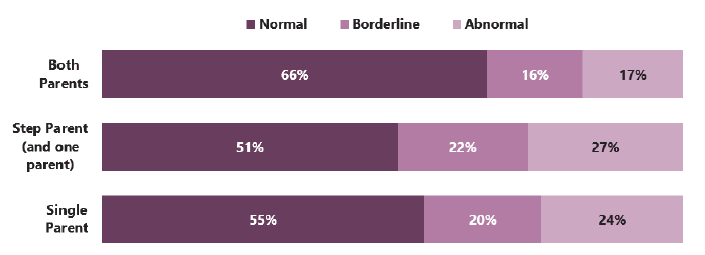
This graph shows overall SDQ scores based on family status categories of living with ‘both parents’, a ‘step parent (and one parent)’, or with a ‘single parent.’ The figure indicates that for pupils living both parents, 66% score within the normal range, 16% scored within the borderline range, and 17% scored within the abnormal range. The figure also indicates that for pupils living with a step parent (and one parent), 51% scored within the normal range, 22% scored within the borderline range, and 27% scored within the abnormal range. The figure also indicates that for pupils living with a single parent, 55% scored within the normal range, 20% scored within the borderline range, and 24% scored within the abnormal range.
Base: See Appendix A
Mental wellbeing
Mental wellbeing also showed a relationship with family structure. Among all subgroups, those who lived with both parents had better mental wellbeing (a higher mean WEMWBS score) than those who lived with a single or step parent (Figure 4.2).
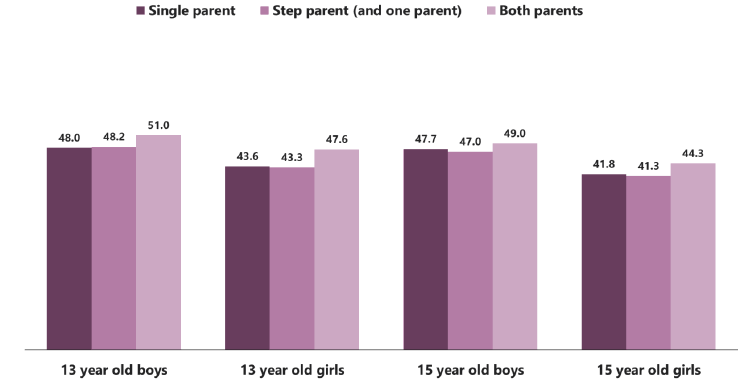
A graph showing the mean WEMWBS scores among 13 year old boys and girls, and 15 year old boys and girls based on whether pupils lived with a ‘single parent’, a ‘step parent (and one parent’, or ‘both parents’.
The figure indicates that 13 year old boys living with a ‘single parent’ had a mean score of 48.0, those living with a ‘step parent (and one parent)’ had a mean score of 48.2, and those living with ‘both parents’ had a mean score of 51.
The figure indicates that 13 year old girls living with a ‘single parent’ had a mean score of 43.6, those living with a ‘step parent (and one parent)’ had a mean score of 43.3, and those living with ‘both parents’ had a mean score of 47.6.
The figure indicates that 15 year old boys living with a ‘single parent’ had a mean score of 47.7, those living with a ‘step parent (and one parent)’ had a mean score of 47, and those living with ‘both parents’ had a mean score of 49.
The figure indicates that 15 year old girls living with a ‘single parent’ had a mean score of 41.8, those living with a ‘step parent (and one parent)’ had a mean score of 41.3, and those living with ‘both parents’ had a mean score of 44.3.
Base: See Appendix A
Talking to parents
Emotional and behavioural problems
Pupils were asked about the likelihood of talking to their father, mother, or another person within their family about something that was worrying them in order to provide an insight into their relationship with their parents and other adults.
Pupils who were unlikely to talk to their parents about something that was worrying them were more likely to have a borderline or abnormal overall SDQ score than those who were likely to talk to their parents. Pupils who were unlikely to talk to their mother were more likely to score borderline or abnormal scores than those who were unlikely to talk to their father.
As Figure 4.3 shows, nearly two-thirds (62%) of pupils who were not at all likely to talk to their father had a borderline or abnormal overall SDQ score, compared with 24% of those who were very or fairly likely to talk to their father.
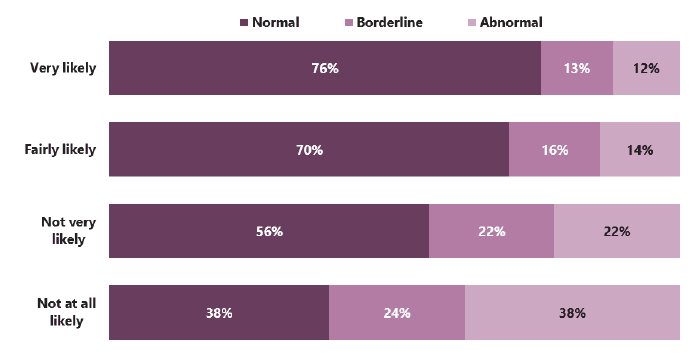
A graph showing overall SDQ score based on whether a pupil answered that they were ‘very likely’, ‘fairly likely’, ‘not very likely’ or ‘not at all likely’ to talk to their father.
The figure indicates that for pupils who were ‘very likely’ to talk to their father, 76% scored within the normal range, 13% scored within the borderline range, and 12% scored in the abnormal range.
The figure indicates that for pupils who were ‘fairly likely’ to talk to their father, 70% scored within the normal range, 16% scored within the borderline range, and 14% scored in the abnormal range.
The figure indicates that for pupils who were ‘not very likely’ to talk to their father, 56% scored within the normal range, 22% scored within the borderline range, and 22% scored in the abnormal range.
The figure indicates that for pupils who were ‘not at all likely’ to talk to their father, 38% scored within the normal range, 24% scored within the borderline range, and 38% scored in the abnormal range.
Base: See Appendix A
The same pattern of borderline or abnormal SDQ scores emerged in terms of a pupil's likelihood to talk to their mother, although to a greater extent. Seventy per cent of pupils who said they are not at all likely to talk with their mother had a borderline or abnormal overall SDQ score, compared with 28% of those who were very likely to talk to their mother if they were worried about something (Figure 4.4).
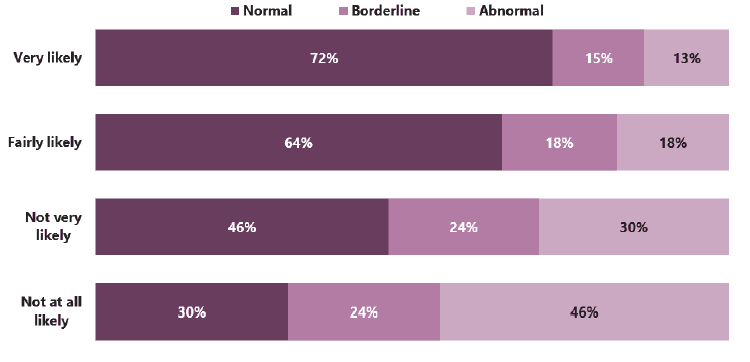
A graph showing overall SDQ score according to whether a pupil answered that they were ‘very likely’, ‘fairly likely’, ‘not very likely’ or ‘not at all likely’ to talk to their mother.
The figure indicates that for pupils who were ‘very likely’ to talk to their mother, 72% scored within the normal range, 15% scored within the borderline range, and 13% scored in the abnormal range.
The figure indicates that for pupils who were ‘fairly likely’ to talk to their mother, 64% scored within the normal range, 18% scored within the borderline range, and 18% scored in the abnormal range.
The figure indicates that for pupils who were ‘not very likely’ to talk to their mother, 46% scored within the normal range, 24% scored within the borderline range, and 30% scored in the abnormal range.
The figure indicates that for pupils who were ‘not at all likely’ to talk to their father, 30% scored within the normal range, 24% scored within the borderline range, and 46% scored in the abnormal range.
Base: See Appendix A
Mental wellbeing
Mental wellbeing was higher among those who were 'very' or 'fairly' likely to talk to their parents than those who were 'not very' or 'not at all' likely to talk to their parents.
The association between willingness to talk to a parent and mental wellbeing was stronger among girls than boys (Figure 4.5 and 4.6).
Among girls of both age groups, the relationship between mental wellbeing and talking to their mother was stronger than that with talking to their father. This was not the case for boys, where the gender of the parent they talked to did not make a difference in terms of their mental wellbeing (Figure 4.5 and 4.6).
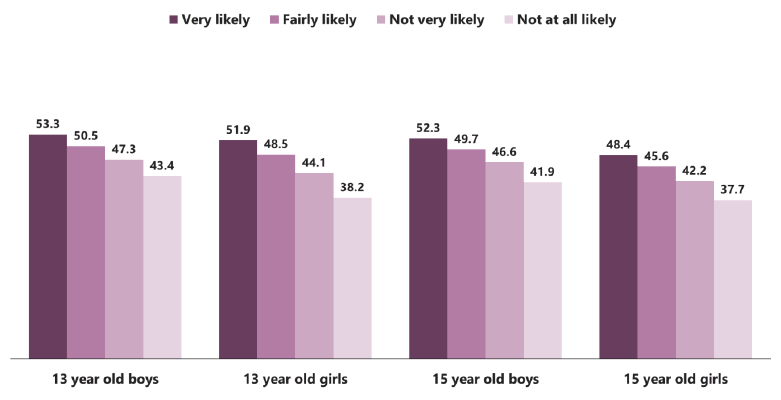
A graph showing the mean WEMWBS scores among 13 year old boys and girls, and 15 year old boys and girls based on how they scored their likelihood of talking to their father.
The figure indicates that 13 year old boys who were ‘very likely’ to talk to their father had a mean score of 53.3, those who were ‘fairly likely’ had a mean score of 50.5, those who were ‘not very likely’ had a mean score of 47.3, and those who were ‘not at all likely’ had a mean score of 43.4.
The figure indicates that 13 year old girls who were ‘very likely’ to talk to their father had a mean score of 51.9, those who were ‘fairly likely’ had a mean score of 48.5, those who were ‘not very likely’ had a mean score of 44.1, and those who were ‘not at all likely’ had a mean score of 38.2.
The figure indicates that 15 year old boys who were ‘very likely’ to talk to their father had a mean score of 52.3, those who were ‘fairly likely’ had a mean score of 49.7, those who were ‘not very likely’ had a mean score of 46.6, and those who were ‘not at all likely’ had a mean score of 41.9.
The figure indicates that 15 year old girls who were ‘very likely’ to talk to their father had a mean score of 48.4, those who were ‘fairly likely’ had a mean score of 45.6, those who were ‘not very likely’ had a mean score of 42.2, and those who were ‘not at all likely’ had a mean score of 37.7.
Base: See Appendix A
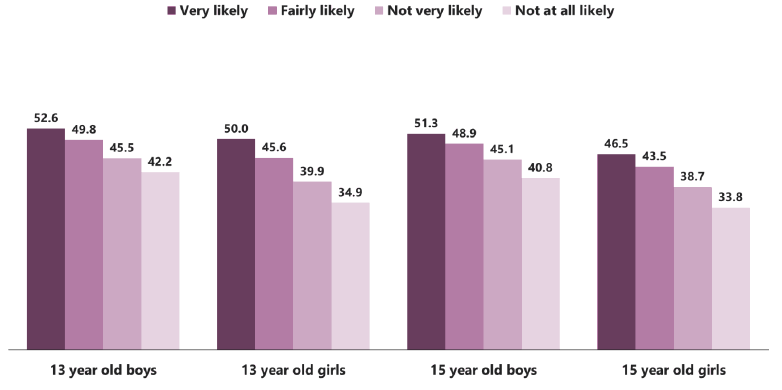
A graph showing the mean WEMWBS scores among 13 year old boys and girls, and 15 year old boys and girls based on how they scored their likelihood of talking to their mother.
The figure indicates that 13 year old boys who were ‘very likely’ to talk to their mother had a mean score of 52.6, those who were ‘fairly likely’ had a mean score of 49.8, those who were ‘not very likely’ had a mean score of 45.5, and those who were ‘not at all likely’ had a mean score of 42.2.
The figure indicates that 13 year old girls who were ‘very likely’ to talk to their mother had a mean score of 50, those who were ‘fairly likely’ had a mean score of 45.6, those who were ‘not very likely’ had a mean score of 39.9, and those who were ‘not at all likely’ had a mean score of 34.9.
The figure indicates that 15 year old boys who were ‘very likely’ to talk to their mother had a mean score of 51.3, those who were ‘fairly likely’ had a mean score of 48.9, those who were ‘not very likely’ had a mean score of 45.1, and those who were ‘not at all likely’ had a mean score of 40.8.
The figure indicates that 15 year old girls who were ‘very likely’ to talk to their mother had a mean score of 46.5, those who were ‘fairly likely’ had a mean score of 43.5, those who were ‘not very likely’ had a mean score of 38.7, and those who were ‘not at all likely’ had a mean score of 33.8.
Base: See Appendix A
Parental knowledge
Emotional and behavioural problems
Pupils are asked how much knowledge ('a lot', 'a little', or 'nothing') their mother and father had about who their friends are, how they spend their money, where they are after school, where they go at night, and what they do with their free time. The answers pupils gave to these questions were used to create a composite knowledge score, which was then banded into three answer categories: pupils who thought their parents know a lot about their activities (an above median[16] composite score), pupils who thought their parents know a reasonable amount about their activities (a median composite score), and those who thought their parents know little about their activities (a below median composite score).
There was a correlation between perceived parental knowledge of activities and a pupil's emotional and behavioural problems. Pupils who thought their parents knew more about their activities were more likely to have normal overall SDQ scores.
Those who thought their father knew little about their activities were almost twice as likely to have a borderline or abnormal total difficulties score than pupils who thought their father knew a lot about their activities (48% and 25%, respectively) (Figure 4.7).
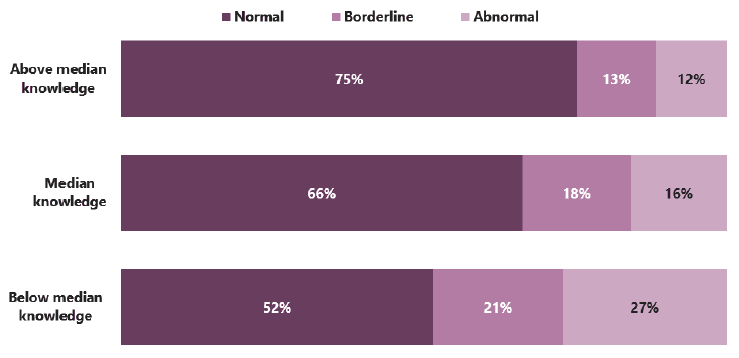
A graph showing overall SDQ scores of pupils based on their perception of their father’s knowledge of their activities.
The figure indicates the pupils who thought their fathers had above median knowledge of their activities, 75% scored within the normal range, 13% scored within the borderline range, and 12% scored in the abnormal range.
The figure indicates the pupils who thought their fathers had median knowledge of their activities, 66% scored within the normal range, 18% scored within the borderline range, and 16% scored in the abnormal range.
The figure indicates the pupils who thought their fathers had below median knowledge of their activities, 52% scored within the normal range, 21% scored within the borderline range, and 27% scored in the abnormal range.
Base: See Appendix A
There was also a strong relationship between maternal knowledge of activities and emotional and behavioural problems. Pupils who thought their mother knew a little were almost twice as likely to have a borderline or abnormal overall SDQ score than those that thought their mother knew a lot (51%, compared with 26%) (Figure 4.8).
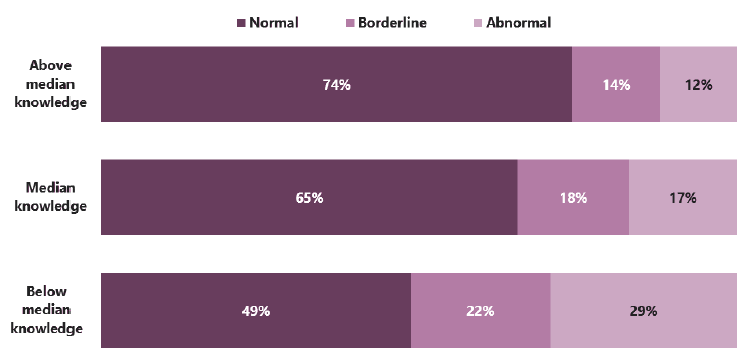
A graph showing overall SDQ scores of pupils based on their perception of their mother’s knowledge of their activities.
The figure indicates the pupils who thought that their mothers had above median knowledge of their activities, 74% scored within the normal range, 14% scored within the borderline range, and 12% scored in the abnormal range.
The figure indicates the pupils who though that their mothers had median knowledge of their activities, 66% scored within the normal range, 18% scored within the borderline range, and 17% scored in the abnormal range.
The figure indicates the pupils who thought that their mothers had below median knowledge of their activities, 49% scored within the normal range, 22% scored within the borderline range, and 29% scored in the abnormal range.
Base: See Appendix A
Mental wellbeing
Mental wellbeing was correlated with perceived parental knowledge of activities. Pupils who thought their parents know more about their activities are more likely to have better mental wellbeing (a higher mean WEMWBS score).
The association between mean WEMWBS score and father's knowledge was stronger among girls than among boys. While there was no difference between 13 and 15 year old boys, the correlation between mental wellbeing was stronger among 13 year girls than 15 year old girls (Figure 4.9).
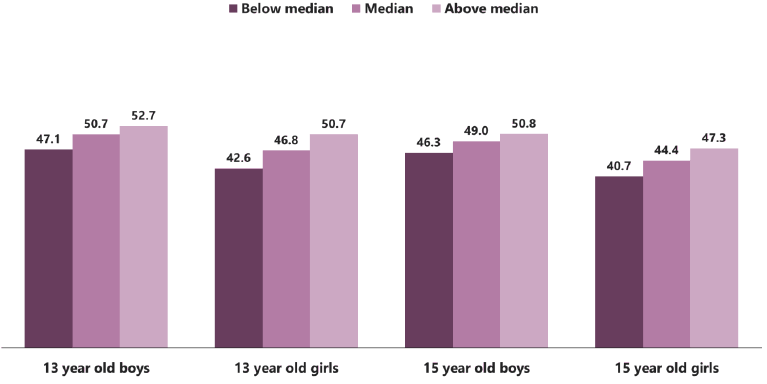
A graph showing the mean WEMWBS scores among 13 year old boys and girls, and 15 year old boys and girls based on their father’s knowledge of their activities.
The figure indicates that 13 year old boys who thought their fathers had ‘below median’ knowledge of their activities had a mean score of 47.1. Those who thought their father had ‘median’ knowledge had a mean score of 50.7, and those who thought their father had above median knowledge had a mean score of 52.7.
The figure indicates that 13 year old girls who thought their fathers had ‘median’ knowledge of their activities had a mean score of 42.6. Those who thought their father had ‘median’ knowledge had a mean score of 46.8, and those who thought their father had above median knowledge had a mean score of 50.7.
The figure indicates that 15 year old boys who thought their fathers had ‘median’ knowledge of their activities had a mean score of 46.3. Those who thought their father had ‘median’ knowledge had a mean score of 49, and those who thought their father had above median knowledge had a mean score of 50.8.
The figure indicates that for 15 year old girls who thought their fathers had ‘median’ knowledge of their activities had a mean score of 40.7. Those who thought their father had ‘median’ knowledge had a mean score of 44.4, and those who thought their father had above median knowledge had a mean score of 47.3.
Base: See Appendix A
The same pattern emerged for mother's knowledge, although to a greater extent. The greatest difference was, again, among 13 year old girls: the mean WEMWBS score of 41.1 among those who thought their mother knew little rose to 50.8 among those who thought their mother knew a lot (Figure 4.10).
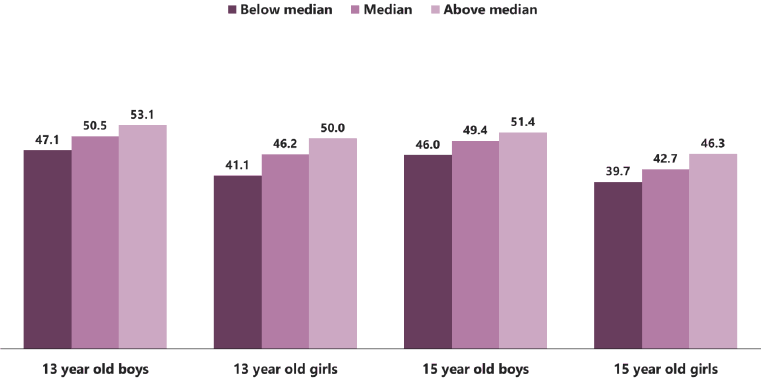
A graph showing the mean WEMWBS scores among 13 year old boys and girls, and 15 year old boys and girls based on their perception of their mother’s knowledge of their activities.
The figure indicates that for 13 year old boys, those that perceived their mother to have ‘below median’ knowledge of their activities had a mean score of 47.1, those that perceived their mother to have ‘median’ knowledge had a mean score of 50.5, and those that perceived their mother to have above median knowledge had a mean score of 53.1.
The figure indicates that for 13 year old girls, those that perceived their mother to have ‘below median’ knowledge of their activities had a mean score of 41.1, those that perceived their mother to have ‘median’ knowledge had a mean score of 46.2, and those that perceived their mother to have above median knowledge had a mean score of 50.0.
The figure indicates that for 15 year old boys, those that perceived their mother to have ‘below median’ knowledge of their activities had a mean score of 46, those that perceived their mother to have ‘median’ knowledge had a mean score of 49.4, and those that perceived their mother to have above median knowledge had a mean score of 51.4.
The figure indicates that for 15 year old girls, those that perceived their mother to have ‘below median’ knowledge of their activities had a mean score of 39.7, those that perceived their mother to have ‘median’ knowledge had a mean score of 42.7, and those that perceived their mother to have above median knowledge had a mean score of 46.3.
Base: See Appendix A
Contact
Email: salsus@gov.scot
There is a problem
Thanks for your feedback